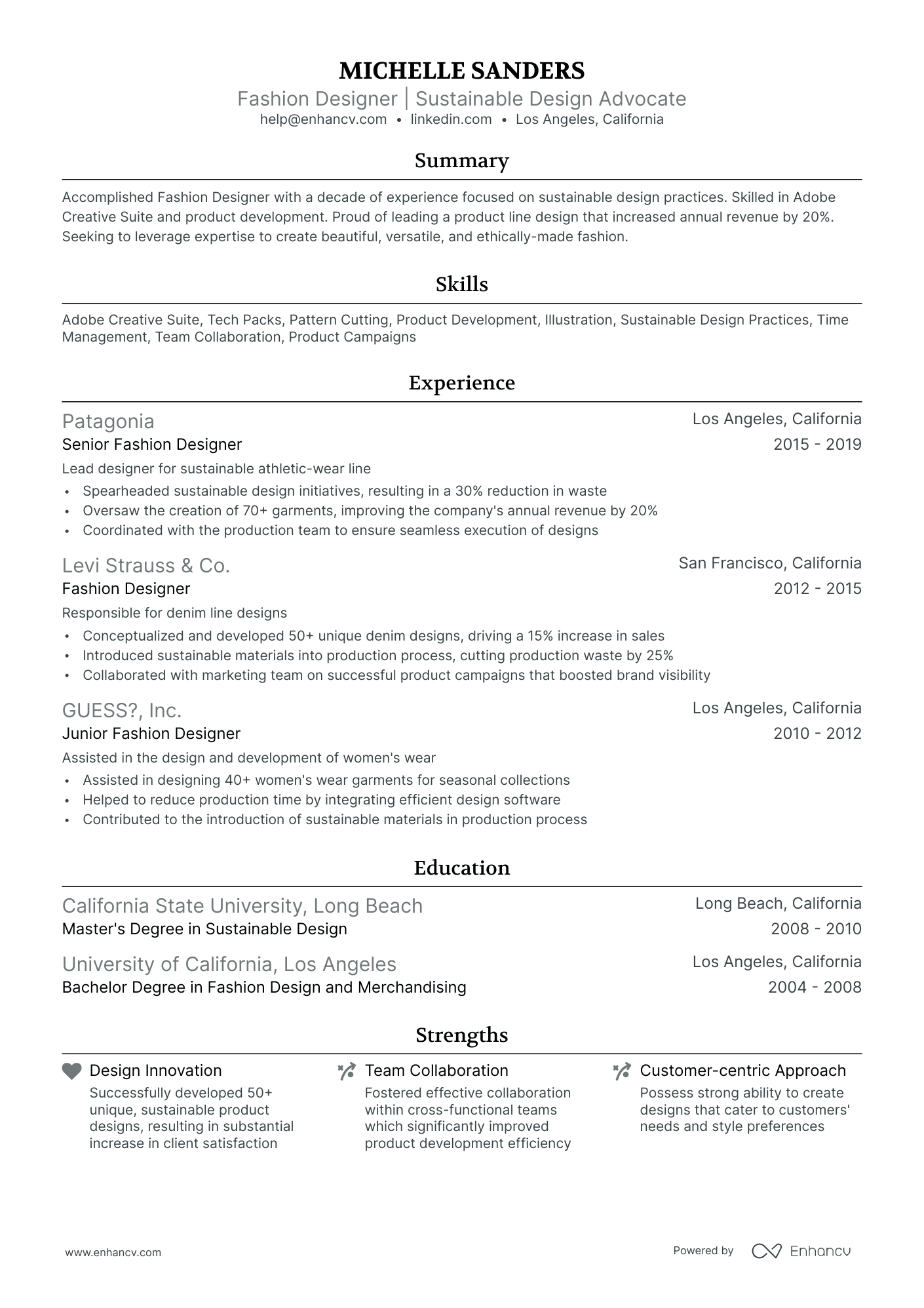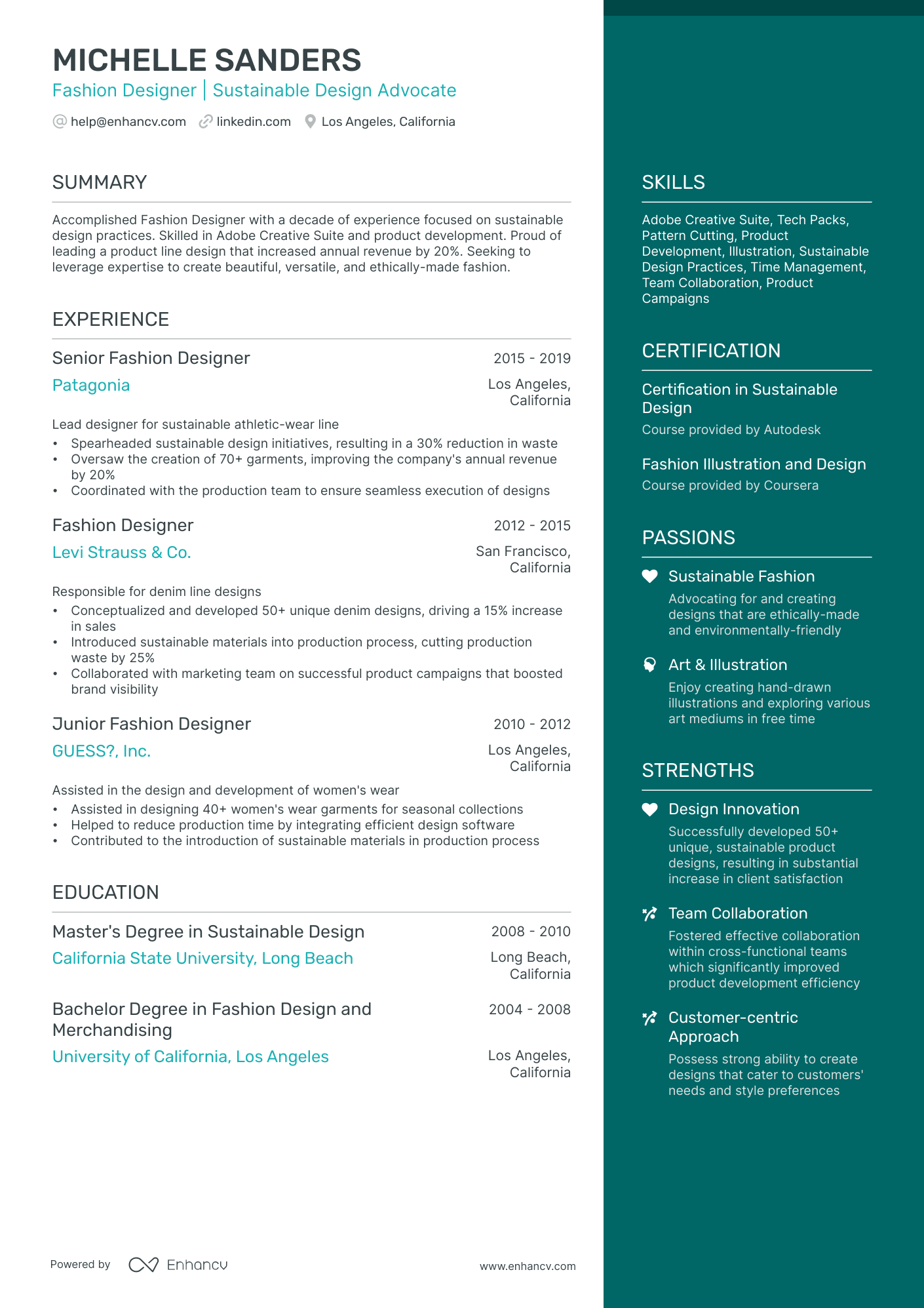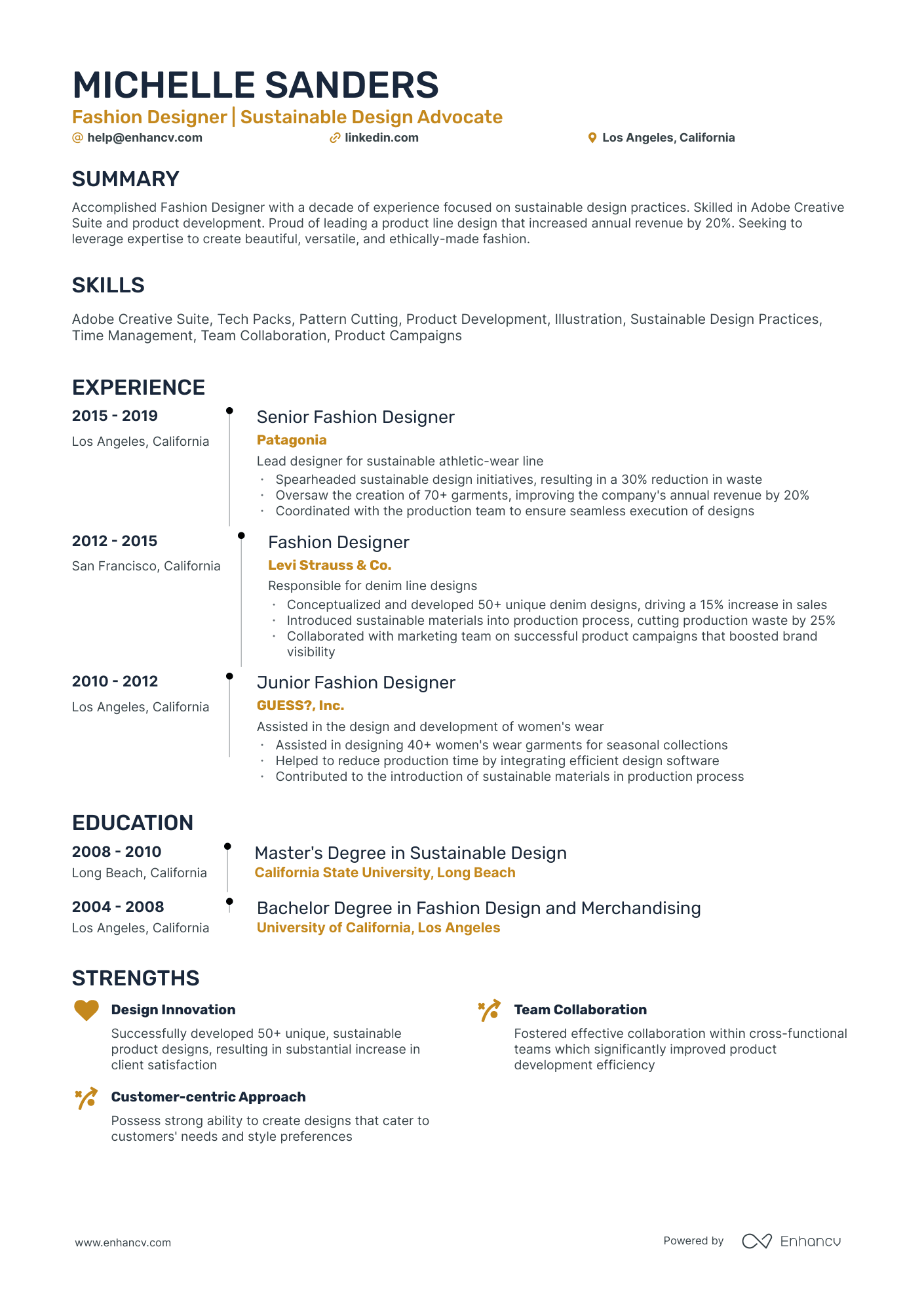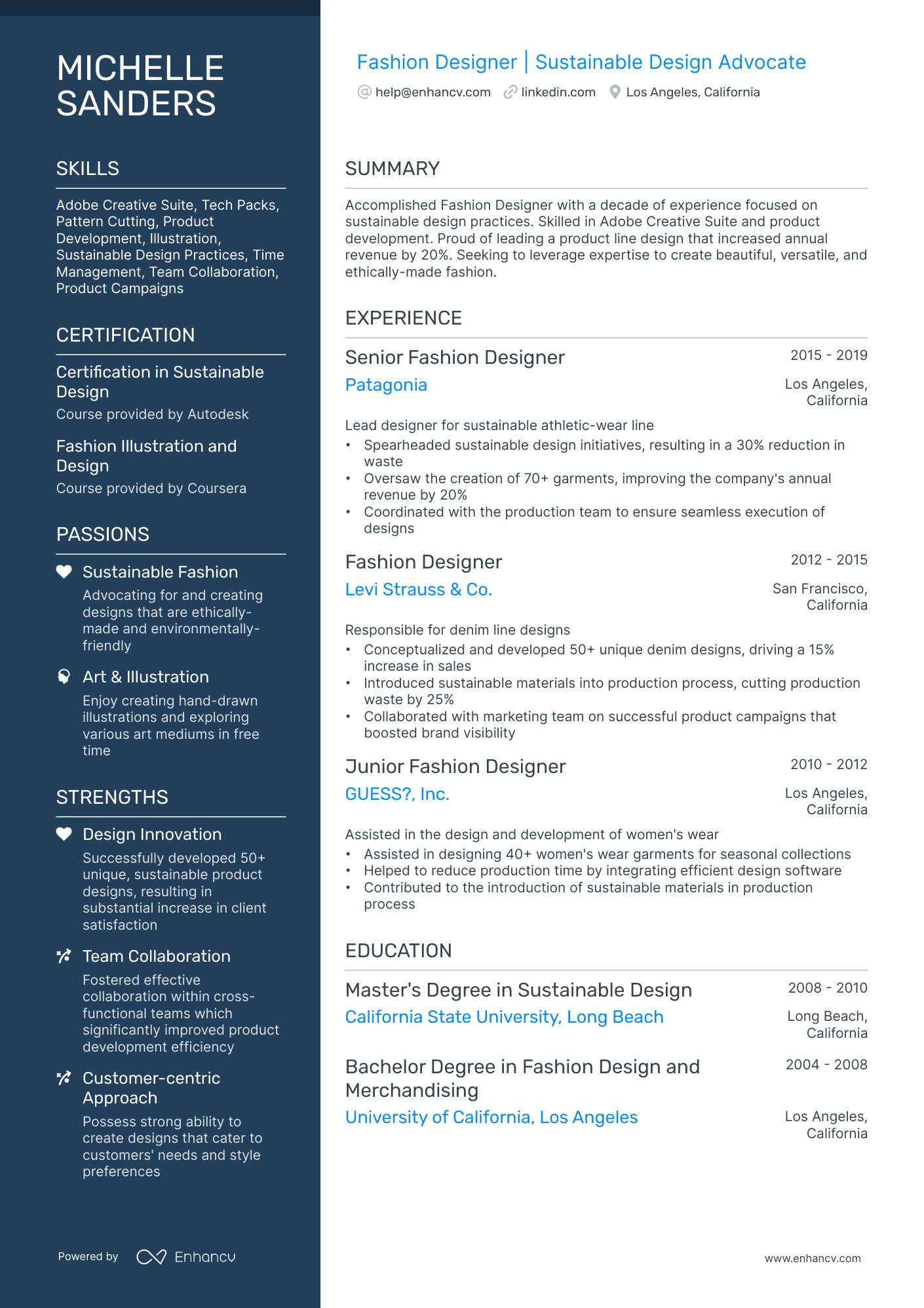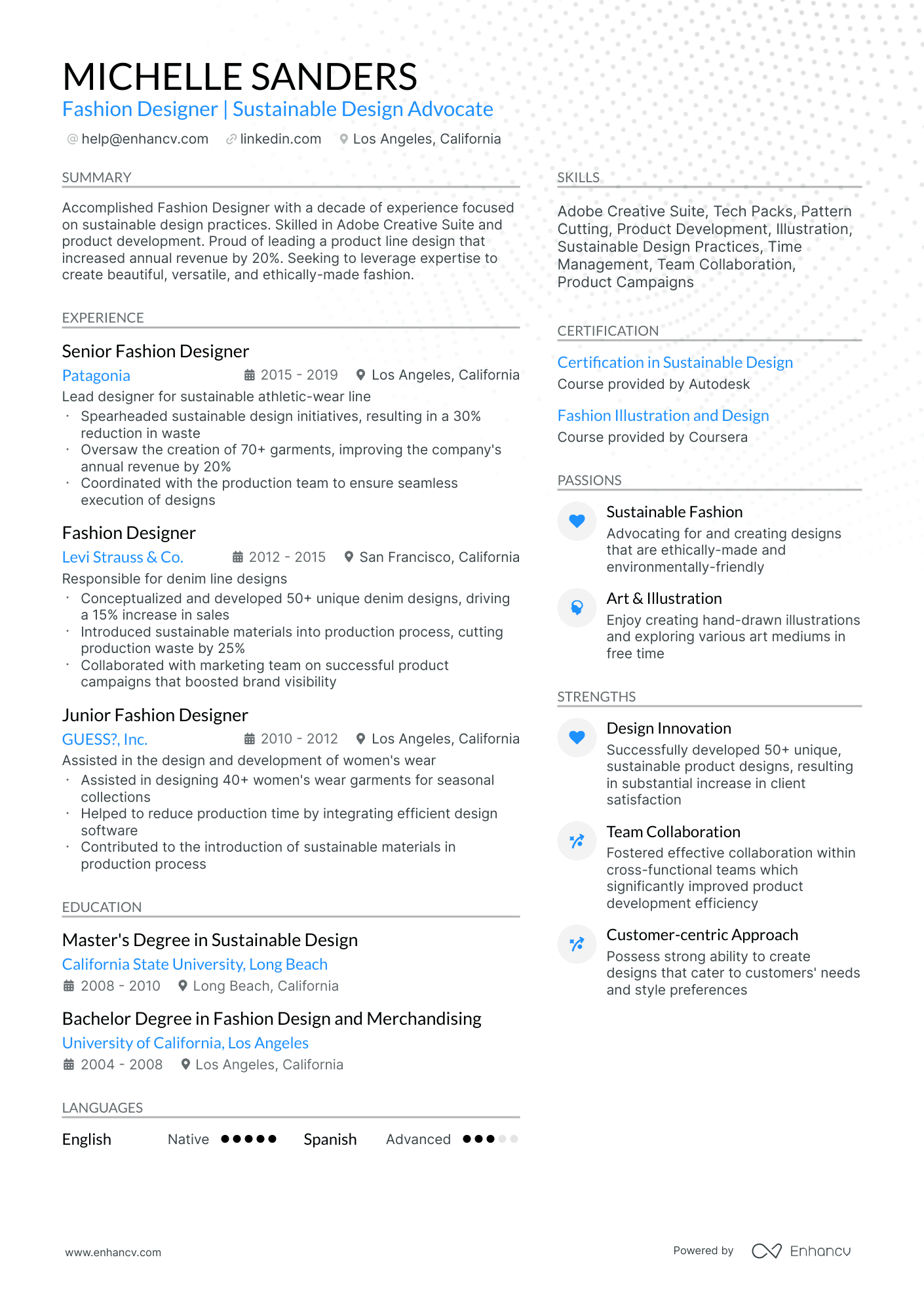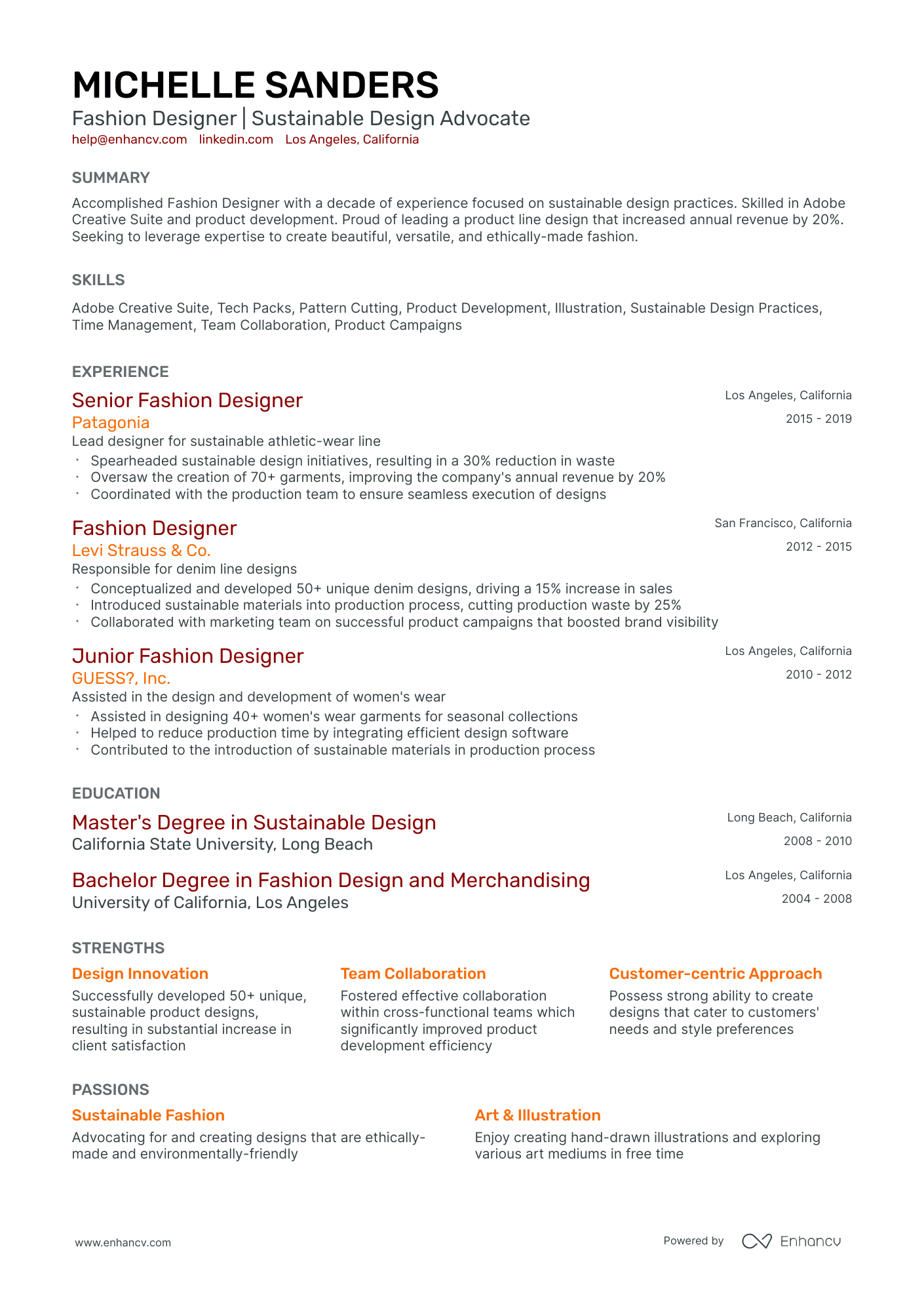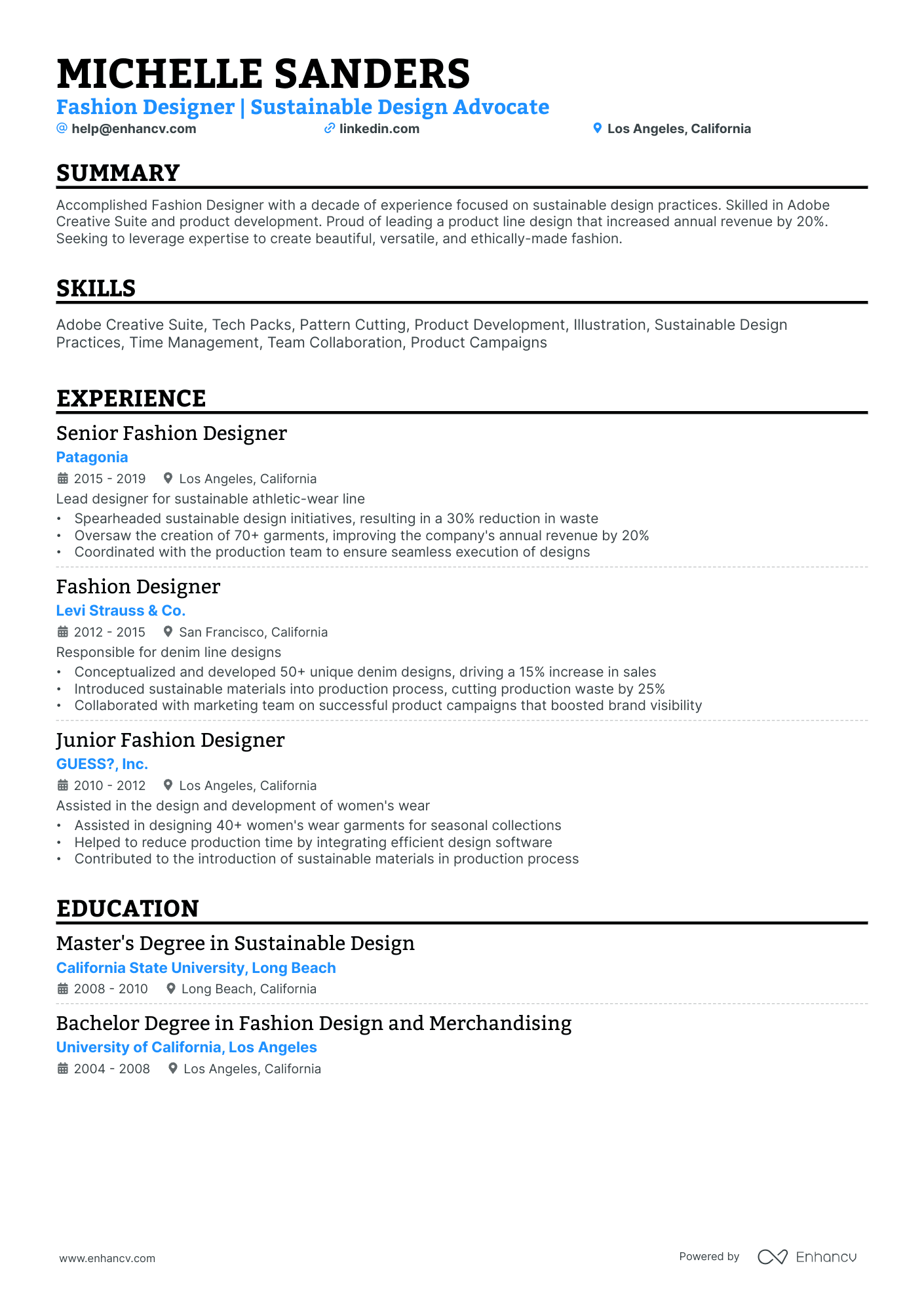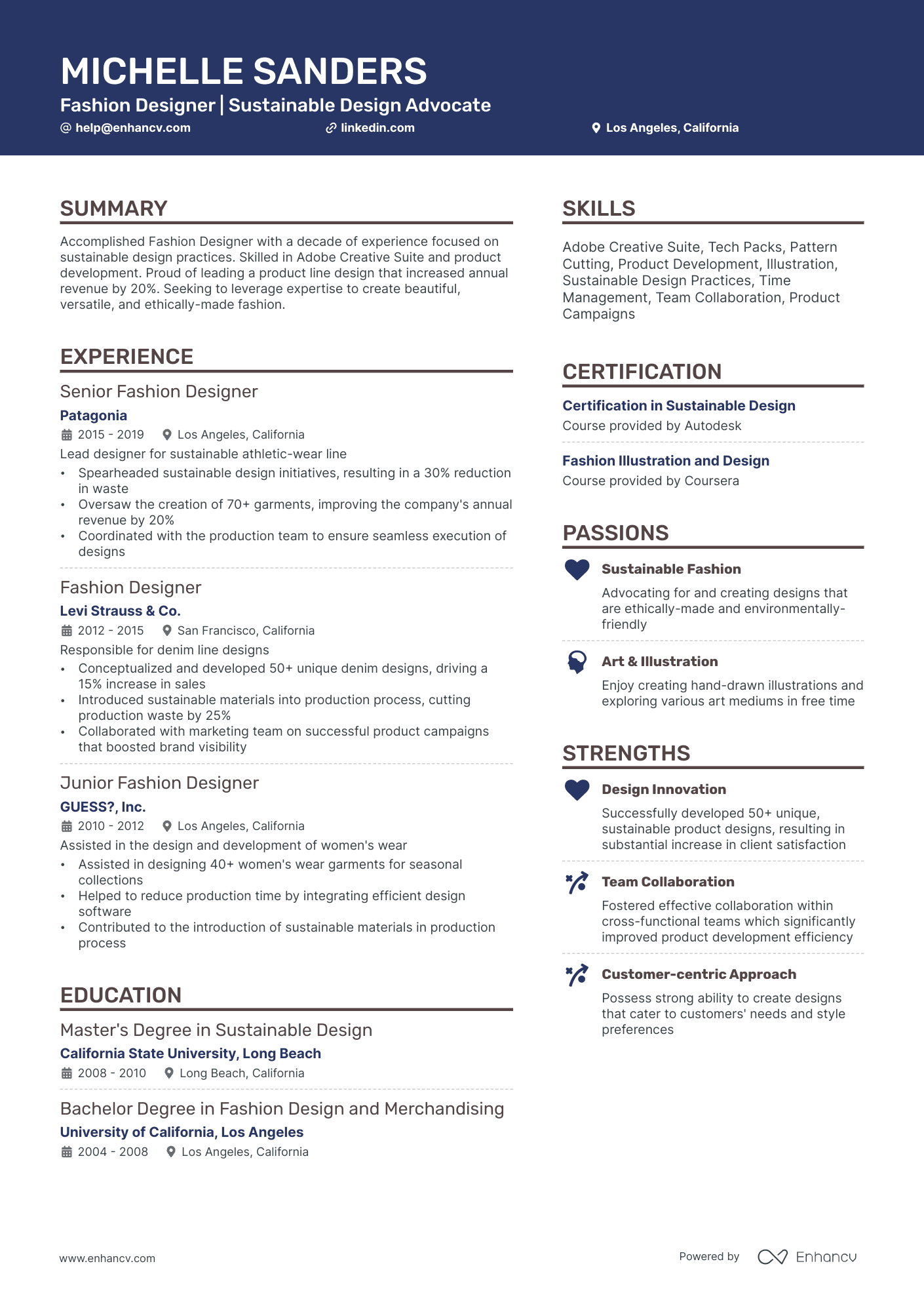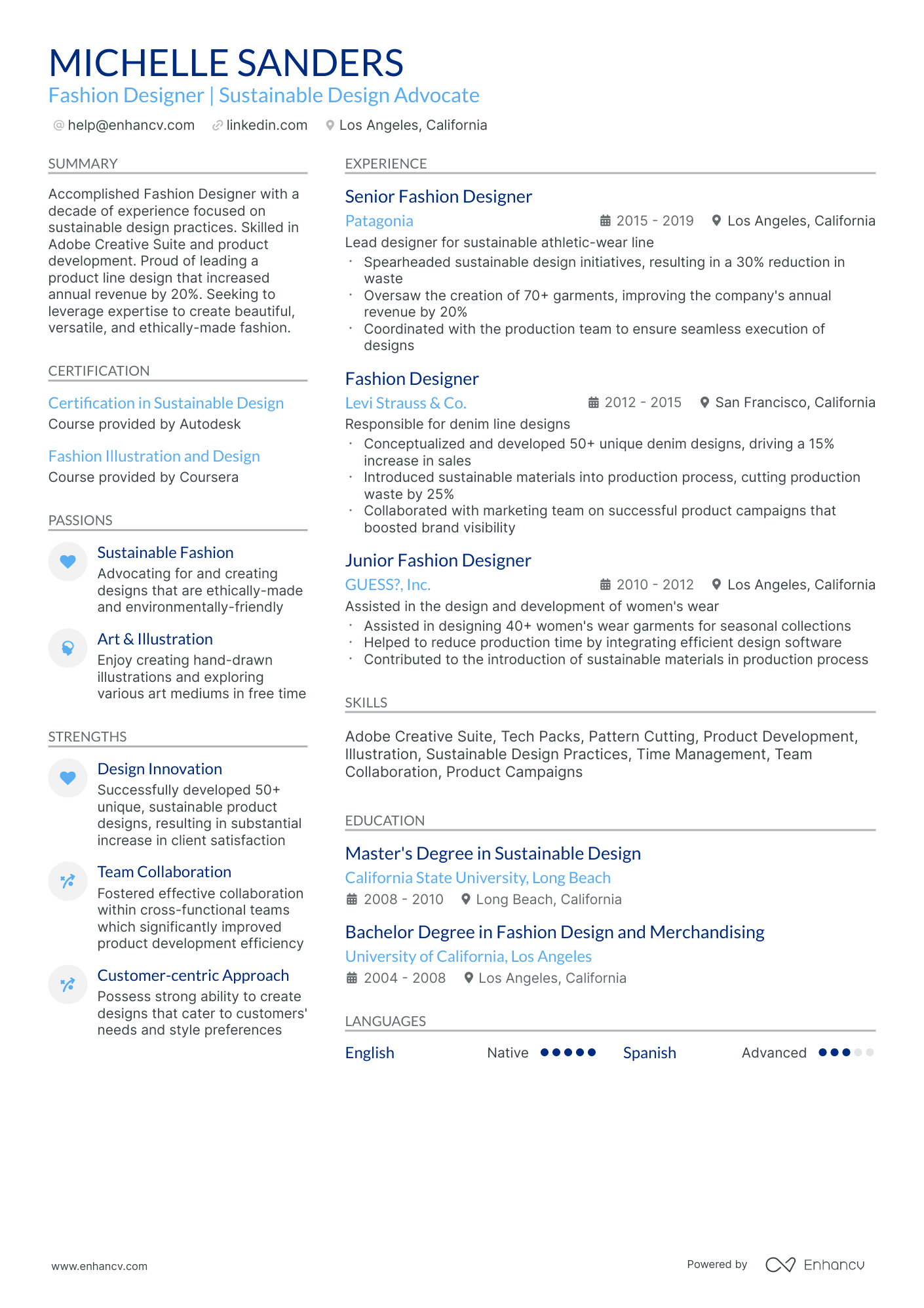A common resume challenge faced by design interns involves demonstrating relevant expertise without extensive professional experience. Our guide can assist in addressing this problem by providing tips on leveraging academic projects, coursework, and extracurricular activities to highlight applicable design skills and creativity.
Dive into our concise guide to learn how to:
- Show your design intern career's brightest moments through your resume's summary, objective, and experience sections.
- Explore top-notch design intern resume examples to understand how to distinguish yourself from other candidates.
- Identify the most sought-after design intern skills and certifications in the industry.
- Design a structured yet unique resume layout.
Recommended reads:
Crafting an impeccable design intern resume format in four steps
Your design intern resume format should be both strategic and reader-friendly. Here's a concise guide to help you achieve that:
- Choose a format that aligns with the job's requirements. If your expertise is directly relevant, the reverse-chronological format is ideal. If you're focusing more on skills, consider the functional or hybrid formats.
- Header: Ensure it's populated with accurate contact details and any relevant portfolio links.
- Length: A one-page resume is standard, but if you have extensive experience, extending to two pages is acceptable.
- File type: To maintain formatting consistency, always opt for PDF.
Upload your resume
Drop your resume here or choose a file. PDF & DOCX only. Max 2MB file size.
Pro tip
Consider incorporating design elements like icons or charts to enhance your resume's visual appeal and readability. But remember, the key is subtlety; don't let design overshadow content.
Elevate your design intern resume with these essential sections:
- Header: The go-to section for recruiters seeking your contact details, portfolio, or current role.
- Summary or objective: A snapshot of your achievements and aspirations.
- Experience: A testament to your technical and interpersonal prowess.
- Skills: A showcase of your capabilities aligned with the job requirements.
- Certifications/Education: A reflection of your commitment to staying updated in the industry.
What recruiters want to see on your resume:
- Proficiency in design software: A solid understanding of platforms like Adobe Creative Suite (Illustrator, Photoshop, InDesign) or other relevant design applications.
- Portfolio showcasing work: Recruiters want to see examples of your design work, ideally in a portfolio that demonstrates creativity, originality, and proficiency in various design styles and mediums.
- Creative problem-solving skills: The ability to use design thinking to solve problems is highly valued. This includes demonstrating how you have used design principles to meet project goals or solve complex issues.
- Understanding of basic design principles: Knowledge of fundamental elements such as color theory, typography, layout, and branding is essential for a design role.
- Ability to work collaboratively: Design often involves working as part of a team, so evidence of effective collaboration, communication, and teamwork skills can be a significant advantage.
Recommended reads:
The experience section of your design intern resume: your professional journey
The experience section is your platform to narrate your professional story. Recruiters scrutinize this section to gauge your unique value proposition.
Here are five steps to craft a compelling experience section:
- Highlight relevant roles, including the company, role description, and tenure, supported by up to six bullet points per role.
- Emphasize tangible outcomes of your contributions, using quantifiable metrics where possible.
- Integrate positive feedback or endorsements to bolster your claims.
- Ensure verb tense consistency when detailing responsibilities.
- Summarize significant achievements relevant to each role.
Explore how seasoned design intern professionals have crafted their experience sections to secure roles at industry-leading firms.
- Collaborated with senior designers to create engaging user interfaces for mobile applications, resulting in a 30% increase in user satisfaction.
- Assisted in the development of wireframes and prototypes for website redesign projects, improving overall website usability by 25%.
- Conducted competitor analysis and market research to identify design trends and incorporate them into new product concepts.
- Designed visually appealing graphics and layouts for print materials, such as brochures and flyers, resulting in a 20% increase in customer engagement.
- Assisted in the creation of brand guidelines to maintain consistency across various marketing channels.
- Collaborated with cross-functional teams to develop creative solutions for client projects within strict deadlines.
- Supported the design team in creating compelling visual assets for online advertising campaigns, leading to a 15% increase in click-through rates.
- Assisted in the production of multimedia presentations for client pitches, resulting in a 50% increase in successful proposals.
- Utilized Adobe Creative Suite to design and modify marketing collateral, ensuring consistent branding across all materials.
- Collaborated with UX designers to develop user-centered wireframes and interactive prototypes for web and mobile applications.
- Participated in usability testing sessions and implemented design improvements based on user feedback resulting in a 35% increase in user satisfaction.
- Assisted in the creation of visual assets and graphics for marketing campaigns, contributing to a 40% increase in brand awareness.
- Contributed to the redesign of the company website, resulting in a 30% increase in website traffic within six months.
- Assisted in the development of user interface mockups and interactive prototypes for software applications.
- Collaborated with the marketing team to create visually appealing infographics that effectively communicated complex concepts to clients.
- Utilized HTML and CSS to code and implement responsive designs for various client websites.
- Assisted in the creation of animated banners and rich media advertisements, resulting in a 25% increase in click-through rates.
- Collaborated with the development team to ensure seamless integration of design elements into web applications.
- Created visually appealing graphics and illustrations for marketing materials, resulting in a 20% increase in customer engagement.
- Assisted in the development of user interface mockups and prototypes for mobile applications.
- Collaborated with the branding team to maintain brand consistency across all design materials.
- Contributed to the design and layout of company presentations, resulting in a 30% increase in client satisfaction.
- Assisted in the creation of marketing collateral, including brochures and posters, to support promotional campaigns.
- Participated in brainstorming sessions and provided creative input for new product concepts.
- Supported the design team in creating compelling visual assets for social media campaigns, resulting in a 15% increase in follower engagement.
- Assisted in the production of video content, including editing and motion graphics, for marketing purposes.
- Collaborated with cross-functional teams to ensure cohesive brand messaging across different marketing channels.
- Design and develop user-centered interfaces for mobile applications, incorporating the latest design trends and best practices.
- Conduct usability testing sessions and gather user feedback to iterate and improve the overall user experience.
- Collaborate with the development team to ensure seamless integration of design elements into the final product.
Quantifying impact on your resume
<ul>
Crafting the experience section for novice design intern candidates
Lack of extensive experience doesn't equate to an empty resume. Here's how you can enrich your experience section:
- Volunteer Roles: Community involvement often equips you with valuable interpersonal skills, and sometimes even technical ones, relevant to the job.
- Academic Projects: Highlight significant university projects that contributed to the field, showcasing your hands-on experience.
- Internships: Even short-term internships can be invaluable. If they're pertinent to the role, they deserve a spot on your resume.
- Past Jobs: Even if unrelated to the design intern, these roles can demonstrate transferable skills that are beneficial for the position.
Recommended reads:
Pro tip
Remember, the experience section isn't just about traditional roles. It's a space to highlight all professional learning, whether from internships, contract roles, research projects, or other relevant experiences. If it's added value to your skill set for the design intern role, it deserves a mention.
Highlighting your hard and soft skills on your design intern resume
The skills section of your design intern resume should showcase your capabilities that align with job requirements.
Your hard skills, or technical skills, demonstrate your proficiency with technological innovations and specific software. On the other hand, your soft skills illustrate how you'd excel in the workplace environment with personal attributes like resilience, negotiation, and organization.
For a well-rounded design intern resume, it's essential to include both. Here's how to craft a standout skills section:
- Prioritize skills listed at the top of the job advert.
- Highlight unique skills you've honed over time.
- Choose soft skills that resonate with the company or department culture.
- Address essential job requirements by listing key skills for the design intern role that haven't been mentioned elsewhere in your resume.
Check out our sample skill list for design intern to get ideas on the most sought-after hard and soft skills in the industry.
Top skills for your design intern resume:
Adobe Creative Suite
Sketch
Figma
InVision
HTML/CSS
JavaScript
Prototyping tools
Wireframing
Graphic Design
UX/UI Design
Communication
Collaboration
Creativity
Time Management
Attention to Detail
Problem Solving
Adaptability
Critical Thinking
Open-mindedness
Feedback Reception
Pro tip
When detailing your skills, always back them up with tangible evidence, be it quantifiable results or certifications.
Highlighting your educational and certification milestones on your design intern resume
While skills alignment is increasingly prioritized, your educational background and certifications still play a pivotal role in establishing credibility.
To effectively present your academic and certification achievements:
- Detail your educational journey, including the institution and duration.
- Highlight recent and relevant certifications, showcasing your commitment to continuous learning.
- Be concise; focus on the skills and knowledge gained rather than exhaustive details.
- If a certification is in progress, mention the expected completion date.
Remember, authenticity is key. If a certification is pending, be transparent about it.
Best certifications to list on your resume
Pro tip
Listing your relevant degrees or certificates on your design intern resume is a win-win situation. Not only does it hint at your technical capabilities in the industry, but also at a range of soft skills, including perseverance, adaptability, and motivation.
Recommended reads:
Summary or objective: making your design intern resume shine
Start your resume with a strong summary or objective to grab the recruiter's attention.
- Use a resume objective if you're newer to the field. Share your career dreams and strengths.
- Opt for a resume summary if you have more experience. Highlight up to five of your top achievements.
Tailor your summary or objective for each job. Think about what the recruiter wants to see.
Resume summary and objective examples for a design intern resume
Additional sections to elevate your design intern resume
Recruiters often seek candidates who offer more than just the basics.
To stand out, consider adding:
- Interests: Share hobbies or activities that reveal your personality and transferable skills.
- Projects: Highlight innovative work that showcases your expertise.
- Languages: If communication is vital for the role, showcase your linguistic abilities.
- Awards: Feature significant recognitions that underscore your expertise.
Key takeaways
- Craft a design intern resume that's easy to read and aligns with the role's requirements.
- The top third of your resume should clearly convey your unique value proposition for the design intern role.
- Tailor your resume to the job, highlighting skills, achievements, and the tangible results of your efforts.
- Detail your certifications and technical skills to demonstrate proficiency with specific tools and technologies.
- The sections you choose should collectively present a comprehensive view of your professional expertise and personality.
